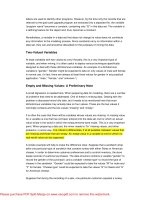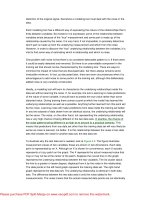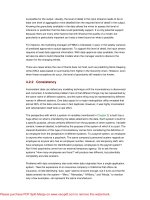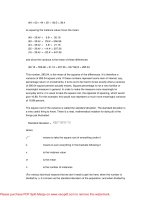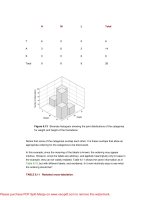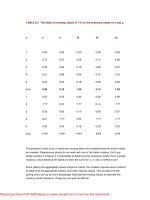Spark for data science
Bạn đang xem bản rút gọn của tài liệu. Xem và tải ngay bản đầy đủ của tài liệu tại đây (12.88 MB, 339 trang )
Spark for Data Science
Analyze your data and delve deep into the world of
machine learning with the latest Spark version, 2.0
Srinivas Duvvuri
Bikramaditya Singhal
BIRMINGHAM - MUMBAI
Spark for Data Science
Copyright © 2016 Packt Publishing
All rights reserved. No part of this book may be reproduced, stored in a retrieval system, or
transmitted in any form or by any means, without the prior written permission of the
publisher, except in the case of brief quotations embedded in critical articles or reviews.
Every effort has been made in the preparation of this book to ensure the accuracy of the
information presented. However, the information contained in this book is sold without
warranty, either express or implied. Neither the authors, nor Packt Publishing, and its
dealers and distributors will be held liable for any damages caused or alleged to be caused
directly or indirectly by this book.
Packt Publishing has endeavored to provide trademark information about all of the
companies and products mentioned in this book by the appropriate use of capitals.
However, Packt Publishing cannot guarantee the accuracy of this information.
First published: September 2016
Production reference: 1270916
Published by Packt Publishing Ltd.
Livery Place
35 Livery Street
Birmingham
B3 2PB, UK.
ISBN 978-1-78588-565-5
www.packtpub.com
Credits
Authors
Srinivas Duvvuri
Bikramaditya Singhal
Copy Editors
Safis Editing
Reviewers
Daniel Frimer
Priyansu Panda
Yogesh Tayal
Project Coordinator
Kinjal Bari
Commissioning Editor
Dipika Gaonkar
Proofreader
Safis Editing
Acquisition Editors
Tushar Gupta
Nikhil Karkal
Indexer
Pratik Shirodkar
Content Development Editor
Rashmi Suvarna
Graphics
Kirk D'Penha
Technical Editor
Deepti Tuscano
Production Coordinator
Shantanu N. Zagade
Foreword
Apache Spark is one of the most popular projects in the Hadoop ecosystem and possibly the
most actively developed open source project in big data. Its simplicity, performance, and
flexibility have made it popular not only among data scientists but also among engineers,
developers, and everybody else interested in big data.
With its rising popularity, Duvvuri and Bikram have produced a book that is the need of
the hour, Spark for Data Science, but with a difference. They have not only covered the
Spark computing platform but have also included aspects of data science and machine
learning. To put it in one word—comprehensive.
The book contains numerous code snippets that one can use to learn and also get a jump
start in implementing projects. Using these examples, users also start to get good insights
and learn the key steps in implementing a data science project—business understanding,
data understanding, data preparation, modeling, evaluation and deployment.
Venkatraman Laxmikanth
Managing Director
Broadridge Financial Solutions India (Pvt) Ltd
About the Authors
Srinivas Duvvuri is currently Senior Vice President Development, heading the
development teams for Fixed Income Suite of products at Broadridge Financial Solutions
(India) Pvt Ltd. In addition, he also leads the Big Data and Data Science COE and is the
principal member of the Broadridge India Technology Council. He is self learnt Data
Scientist. The Big Data /Data Science COE in the past 3 years, has successfully completed
multiple POC’s and some of the use cases are moving towards production deployment. He
has over 25+ years of experience in software product development. His experience spans
predominantly in product development in, multiple domains Financial Services,
Infrastructure Management, OLAP, Telecom Billing and Customer Care, CAD/CAM. Prior
to Broadridge, he’s held leadership positions at a Startup and leading IT majors such as CA,
Hyperion (Oracle), Globalstar. He has a patent in Relational OLAP.
Srinivas loves to teach and mentor budding Engineers. He has established strong Academic
connect and interacts with a host of educational institutions, He is an active speaker in
various conferences, summits and meetups on topics such as Big data, Data Science
Srinivas is a B.Tech in Aeronautical Engineering and M.Tech in Computer Science, from IIT,
Madras.
At the outset I would like to thank VLK our MD and Broadridge India for supporting me in this
endeavor. I would like to thank my parents, teachers, colleagues and extended family who have
mentored and motivated me. My thanks to Bikram who agreed me to be the co-author when proposal
to author the book came up. My special thanks to my wife Ratna, sons Girish and Aravind who have
supported me in completing this book.
I would also like to sincerely thank the editorial team from Packt Arshriya, Rashmi, Deepti and all
those, though not mentioned here, who have contributed in this project. Finally last but not the least
our publisher Packt.
Bikramaditya Singhal is a data scientist with about 7 years of industry experience. He is an
expert in statistical analysis, predictive analytics, machine learning, Bitcoin, Blockchain, and
programming in C, R, and Python. He has extensive experience in building scalable data
analytics solutions in many industry sectors. He also has an active interest on industrial IoT,
machine to machine communication, decentralized computation through Blockchain and
Artificial Intelligence.
Bikram currently leads the data science team of ‘Digital Enterprise Solutions’ group at Tech
Mahindra Ltd. He also worked in companies such as Microsoft India, Broadridge, Chelsio
Communications and also cofounded a company named ‘Mund Consulting’ which focused
on Big Data analytics.
Bikram is an active speaker in various conferences, summits and meetups on topics such as
big data, data science, IIoT and Blockchain.
I would like to thank my father, my brothers Manoj Agrawal and Sumit Mund for their mentorship.
Without learning from them, there is not a chance I could be doing what I do today, and it is because
of them and others that I feel compelled to pass my knowledge on to those willing to learn. Special
thanks to my mentor and coauthor Srinivas Duvvuri, and my friend Priyansu Panda, without their
efforts this book quite possibly would not have happened.
My deepest gratitude to his holiness Sri Sri Ravi Shankar for building me to what I am today. Many
thanks and gratitude to my parents and my wife Yashoda for their unconditional love and support.
I would also like to sincerely thank all those, though not mentioned here, who have contributed in this
project directly or indirectly.
About the Reviewers
Daniel Frimer has been involved in a vast exposure of industries across Healthcare, Web
Analytics, Transportation. Across these industries has developed ways to optimize the
speed of data workflow, storage, and processing in the hopes of making a highly efficient
department. Daniel is currently a Master’s candidate at the University of Washington in
Information Sciences pursuing a specialization in Data Science and Business
Intelligence. She worked on Python Data Science Essentials
I’d like to thank my grandmother Mary. Who has always believed in mine and everyone’s potential
and respects those whose passions make the world a better place.
Priyansu Panda is a research engineer at Underwriters Laboratories, Bangalore, India. He
worked as a senior system engineer in Infosys Limited, and served as a software engineer in
Tech Mahindra.
His areas of expertise include machine-learning, natural language processing, computer
vision, pattern recognition, and heterogeneous distributed data integration. His current
research is on applied machine learning for product safety analysis. His major research
interests are machine-learning and data-mining applications, artificial intelligence on
internet of things, cognitive systems, and clustering research.
Yogesh Tayal is a Technology Consultant at Mu Sigma Business Solutions Pvt. Ltd. and has
been with Mu Sigma for more than 3 years. He has worked with the Mu Sigma Business
Analytics team and is currently an integral part of the product development team. Mu
Sigma is one of the leading Decision Sciences companies in India with a huge client base
comprising of leading corporations across an array of industry verticals i.e. technology,
retail, pharmaceuticals, BFSI, e-commerce, healthcare etc.
www.PacktPub.com
For support files and downloads related to your book, please visit www.PacktPub.com.
Did you know that Packt offers eBook versions of every book published, with PDF and
ePub files available? You can upgrade to the eBook version at www.PacktPub.com and as a
print book customer, you are entitled to a discount on the eBook copy. Get in touch with us
at for more details.
At www.PacktPub.com, you can also read a collection of free technical articles, sign up for a
range of free newsletters and receive exclusive discounts and offers on Packt books and
eBooks.
/>
Get the most in-demand software skills with Mapt. Mapt gives you full access to all Packt
books and video courses, as well as industry-leading tools to help you plan your personal
development and advance your career.
Why subscribe?
Fully searchable across every book published by Packt
Copy and paste, print, and bookmark content
On demand and accessible via a web browser
Table of Contents
Preface
Chapter 1: Big Data and Data Science – An Introduction
Big data overview
Challenges with big data analytics
Computational challenges
Analytical challenges
Evolution of big data analytics
Spark for data analytics
The Spark stack
Spark core
Spark SQL
Spark streaming
MLlib
GraphX
SparkR
Summary
References
Chapter 2: The Spark Programming Model
The programming paradigm
Supported programming languages
Scala
Java
Python
R
Choosing the right language
The Spark engine
Driver program
The Spark shell
SparkContext
Worker nodes
Executors
Shared variables
Flow of execution
The RDD API
1
8
9
10
10
11
12
14
15
16
17
17
18
18
19
19
19
20
21
21
22
22
22
23
23
24
24
25
25
26
26
26
27
28
RDD basics
Persistence
RDD operations
Creating RDDs
Transformations on normal RDDs
The filter operation
The distinct operation
The intersection operation
The union operation
The map operation
The flatMap operation
The keys operation
The cartesian operation
Transformations on pair RDDs
The groupByKey operation
The join operation
The reduceByKey operation
The aggregate operation
Actions
The collect() function
The count() function
The take(n) function
The first() function
The takeSample() function
The countByKey() function
Summary
References
28
29
30
30
34
35
35
36
36
37
37
38
38
39
39
40
41
42
43
44
44
44
44
44
45
46
46
Chapter 3: Introduction to DataFrames
47
Why DataFrames?
Spark SQL
The Catalyst optimizer
The DataFrame API
DataFrame basics
RDDs versus DataFrames
48
49
49
50
51
51
52
52
53
54
56
57
58
59
Similarities
Differences
Creating DataFrames
Creating DataFrames from RDDs
Creating DataFrames from JSON
Creating DataFrames from databases using JDBC
Creating DataFrames from Apache Parquet
Creating DataFrames from other data sources
[ ii ]
DataFrame operations
Under the hood
Summary
References
60
67
67
68
Chapter 4: Unified Data Access
69
Data abstractions in Apache Spark
Datasets
Working with Datasets
Creating Datasets from JSON
Datasets API's limitations
Spark SQL
SQL operations
Under the hood
Structured Streaming
The Spark streaming programming model
Under the hood
Comparison with other streaming engines
Continuous applications
Summary
References
70
72
72
75
76
76
77
79
79
83
86
87
88
89
89
Chapter 5: Data Analysis on Spark
90
Data analytics life cycle
Data acquisition
Data preparation
Data consolidation
Data cleansing
91
93
94
95
96
97
100
103
105
111
112
113
113
114
115
115
117
118
118
Missing value treatment
Outlier treatment
Duplicate values treatment
Data transformation
Basics of statistics
Sampling
Simple random sample
Systematic sampling
Stratified sampling
Data distributions
Frequency distributions
Probability distributions
Descriptive statistics
Measures of location
[ iii ]
Mean
Median
Mode
Measures of spread
Range
Variance
Standard deviation
Summary statistics
Graphical techniques
Inferential statistics
Discrete probability distributions
Bernoulli distribution
Binomial distribution
Sample problem
Poisson distribution
Sample problem
Continuous probability distributions
Normal distribution
Standard normal distribution
Chi-square distribution
Sample problem
Student's t-distribution
F-distribution
Standard error
Confidence level
Margin of error and confidence interval
Variability in the population
Estimating sample size
Hypothesis testing
Null and alternate hypotheses
Chi-square test
F-test
Problem:
Correlations
Summary
References
Chapter 6: Machine Learning
118
119
119
120
120
120
120
122
123
124
124
124
125
126
127
127
128
128
129
132
133
135
136
137
137
138
138
139
139
140
140
142
142
143
144
144
146
Introduction
The evolution
Supervised learning
Unsupervised learning
MLlib and the Pipeline API
MLlib
148
148
148
149
150
150
[ iv ]
ML pipeline
Transformer
Estimator
Introduction to machine learning
Parametric methods
Non-parametric methods
Regression methods
Linear regression
Loss function
Optimization
Regularizations on regression
Ridge regression
Lasso regression
Elastic net regression
Classification methods
Logistic regression
Linear Support Vector Machines (SVM)
Linear kernel
Polynomial kernel
Radial Basis Function kernel
Sigmoid kernel
Training an SVM
Decision trees
Impurity measures
Gini Index
Entropy
Variance
Stopping rule
Split candidates
Categorical features
Continuous features
Advantages of decision trees
Disadvantages of decision trees
Example
Ensembles
Random forests
Advantages of random forests
Gradient-Boosted Trees
Multilayer perceptron classifier
Clustering techniques
K-means clustering
Disadvantages of k-means
Example
[v]
156
157
157
163
165
165
165
166
170
171
171
172
173
174
175
176
178
181
181
181
181
181
183
184
184
185
185
186
186
186
186
187
187
187
192
192
193
193
199
202
202
203
204
Summary
References
205
205
Chapter 7: Extending Spark with SparkR
SparkR basics
Accessing SparkR from the R environment
RDDs and DataFrames
Getting started
Advantages and limitations
Programming with SparkR
Function name masking
Subsetting data
Column functions
Grouped data
SparkR DataFrames
SQL operations
Set operations
Merging DataFrames
Machine learning
The Naive Bayes model
The Gaussian GLM model
Summary
References
Chapter 8: Analyzing Unstructured Data
Sources of unstructured data
Processing unstructured data
Count vectorizer
TF-IDF
Stop-word removal
Normalization/scaling
Word2Vec
n-gram modelling
Text classification
Naive Bayes classifier
Text clustering
K-means
Dimensionality reduction
Singular Value Decomposition
Principal Component Analysis
206
207
208
209
210
211
212
213
214
215
216
217
218
219
220
222
222
224
225
225
226
227
228
231
234
235
237
237
239
241
241
249
249
250
251
252
[ vi ]
Summary
References:
253
253
Chapter 9: Visualizing Big Data
254
Why visualize data?
A data engineer's perspective
A data scientist's perspective
A business user's perspective
Data visualization tools
IPython notebook
Apache Zeppelin
Third-party tools
Data visualization techniques
Summarizing and visualizing
Subsetting and visualizing
Sampling and visualizing
Modeling and visualizing
Summary
References
Data source citations
255
256
256
257
257
258
258
258
259
259
263
267
270
272
273
273
Chapter 10: Putting It All Together
274
A quick recap
Introducing a case study
The business problem
Data acquisition and data cleansing
Developing the hypothesis
Data exploration
Data preparation
Too many levels in a categorical variable
Numerical variables with too much variation
Missing data
Continuous data
Categorical data
Preparing the data
Model building
Data visualization
Communicating the results to business users
Summary
References
Chapter 11: Building Data Science Applications
[ vii ]
275
276
277
277
283
284
286
287
289
289
290
290
291
293
300
300
301
301
302
Scope of development
Expectations
Presentation options
Interactive notebooks
References
Web API
References
PMML and PFA
References
Development and testing
References
Data quality management
The Scala advantage
Spark development status
Spark 2.0's features and enhancements
Unifying Datasets and DataFrames
Structured Streaming
Project Tungsten phase 2
What's in store?
The big data trends
Summary
References
Index
303
303
304
304
304
305
305
305
306
306
307
308
308
310
310
310
311
311
312
312
314
315
316
[ viii ]
Preface
In this smart age, data analytics is the key to sustaining and promoting business growth.
Every business is trying to leverage their data as much possible with all sorts of data science
tools and techniques to progress along the analytics maturity curve. This sudden rise in
data science requirements is the obvious reason for scarcity of data scientists. It is very
difficult to meet the market demand with unicorn data scientists who are experts in
statistics, machine learning, mathematical modelling as well as programming.
The availability of unicorn data scientists is only going to decrease with the increase in
market demand, and it will continue to be so. So, a solution was needed which not only
empowers the unicorn data scientists to do more, but also creates what Gartner calls as
“Citizen Data Scientists”. Citizen data scientists are none other than the developers,
analysts, BI professionals or other technologists whose primary job function is outside of
statistics or analytics but are passionate enough to learn data science. They are becoming
the key enabler in democratizing data analytics across organizations and industries as a
whole.
There is an ever going plethora of tools and techniques designed to facilitate big data
analytics at scale. This book is an attempt to create citizen data scientists who can leverage
Apache Spark’s distributed computing platform for data analytics.
This book is a practical guide to learn statistical analysis and machine learning to build
scalable data products. It helps to master the core concepts of data science and also Apache
Spark to help you jump start on any real life data analytics project. Throughout the book, all
the chapters are supported by sufficient examples, which can be executed on a home
computer, so that readers can easily follow and absorb the concepts. Every chapter attempts
to be self-contained so that the reader can start from any chapter with pointers to relevant
chapters for details. While the chapters start from basics for a beginner to learn and
comprehend, it is comprehensive enough for a senior architects at the same time.
What this book covers
Chapter 1, Big Data and Data Science – An Introduction, this chapter discusses briefly about
the various challenges in big data analytics and how Apache Spark solves those problems
on a single platform. This chapter also explains how data analytics has evolved to what it is
now and also gives a basic idea on the Spark stack.
Preface
Chapter 2, The Spark Programming Model, this chapter talks about the design considerations
of Apache Spark and the supported programming languages. It also explains the Spark core
components and covers the RDD API in details, which is the basic building block of Spark.
Chapter 3, Introduction to DataFrames, this chapter explains about the DataFrames, which
are the most handy and useful component for the data scientists to work at ease. It explains
about Spark SQL and the Catalyst optimizer that empowers DataFrames. Also, various
DataFrames operations are demonstrated with code examples.
Chapter 4, Unified Data Access, this chapter talks about the various ways we source data
from different sources, consolidate and work in a unified way. It covers the streaming
aspect of real time data collection and operating on them. It also talks about the under-thehood fundamentals of these APIs.
Chapter 5, Data Analysis on Spark, this chapter discuss about the complete data analytics
lifecycle. With ample code examples, it explains how to source data from different sources,
prepare the data using data cleaning and transformation techniques, and perform
descriptive and inferential statistics to generate hidden insights from data.
Chapter 6, Machine Learning, this chapter explains various machine learning algorithms,
how they are implemented in the MLlib library and how they can be used with the pipeline
API for a streamlined execution. This chapter covers the fundamentals of all the algorithms
covered so it could serve as a one stop reference.
Chapter 7, Extending Spark with SparkR, this chapter is primarily intended for the R
programmers who want to leverage Spark for Data Analytics. It explains how to program
with SparkR and how to use the machine learning algorithms of R libraries.
Chapter 8, Analyzing Unstructured Data, this chapter discusses only about unstructured
data analysis. It explains how to source unstructured data, process it and perform machine
learning on it. It also covers some of the dimension reduction techniques which were not
covered in the “Machine Learning” chapter.
Chapter 9, Visualizing Big Data, in this chapter, readers learn various visualization
techniques that are supported on Spark. It explains the different kinds of visualization
requirements of data engineers, data scientists and business users; and also suggests right
kinds of tools and techniques. It also talks about leveraging IPython/Jupyter notebook and
Zeppelin, an Apache project for data visualization.
[2]
Preface
Chapter 10, Putting It All Together, till now the book has discussed about most of the data
analytics components in different chapters separately. This chapter is an effort to stich
various steps on a typical data science project and demonstrate a step-by-step approach to a
full blown analytics project execution.
Chapter 11, Building Data Science Applications, till now the book has mostly discussed about
the data science components along with a full blown execution example. This chapter
provides a heads up on how to build data products that can be deployed in production. It
also gives an idea on the current development status of the Apache Spark project and what
is in store for it.
What you need for this book
Your system must have following software before executing the code mentioned in the
book. However, not all software components are needed for all chapters:
Ubuntu 14.4 or, Windows 7 or above
Apache Spark 2.0.0
Scala: 2.10.4
Python 2.7.6
R 3.3.0
Java 1.7.0
Zeppelin 0.6.1
Jupyter 4.2.0
IPython kernel 5.1
Who this book is for
This book is for anyone who wants to leverage Apache Spark for data science and machine
learning. If you are a technologist who wants to expand your knowledge to perform data
science operations in Spark, or a data scientist who wants to understand how algorithms are
implemented in Spark, or a newbie with minimal development experience who wants to
learn about Big Data Analytics, this book is for you!
[3]
Preface
Conventions
In this book, you will find a number of text styles that distinguish between different kinds
of information. Here are some examples of these styles and an explanation of their meaning.
Code words in text, database table names, folder names, filenames, file extensions,
pathnames, dummy URLs, user input, and Twitter handles are shown as follows: "When a
program is run on a Spark shell, it is called the driver program with the user's main method
in it."
A block of code is set as follows:
Scala> sc.parallelize(List(2, 3, 4)).count()
res0: Long = 3
Scala> sc.parallelize(List(2, 3, 4)).collect()
res1: Array[Int] = Array(2, 3, 4)
Scala> sc.parallelize(List(2, 3, 4)).first()
res2: Int = 2
Scala> sc.parallelize(List(2, 3, 4)).take(2)
res3: Array[Int] = Array(2, 3)
New terms and important words are shown in bold. Words that you see on the screen, for
example, in menus or dialog boxes, appear in the text like this: "It also allows users to
source data using Data Source API from the data sources that are not supported out of the
box (for example, CSV, Avro HBase, Cassandra, and so on.)"
Warnings or important notes appear in a box like this.
Tips and tricks appear like this.
[4]
Preface
Reader feedback
Feedback from our readers is always welcome. Let us know what you think about this
book-what you liked or disliked. Reader feedback is important for us as it helps us develop
titles that you will really get the most out of. To send us general feedback, simply email , and mention the book's title in the subject of your
message. If there is a topic that you have expertise in and you are interested in either
writing or contributing to a book, see our author guide at www.packtpub.com/authors.
Customer support
Now that you are the proud owner of a Packt book, we have a number of things to help you
to get the most from your purchase.
Downloading the example code
You can download the example code files for this book from your account at http://www.p
acktpub.com. If you purchased this book elsewhere, you can visit ktpub.c
om/support and register to have the files e-mailed directly to you.
You can download the code files by following these steps:
1.
2.
3.
4.
5.
6.
7.
Log in or register to our website using your e-mail address and password.
Hover the mouse pointer on the SUPPORT tab at the top.
Click on Code Downloads & Errata.
Enter the name of the book in the Search box.
Select the book for which you're looking to download the code files.
Choose from the drop-down menu where you purchased this book from.
Click on Code Download.
Once the file is downloaded, please make sure that you unzip or extract the folder using the
latest version of:
WinRAR / 7-Zip for Windows
Zipeg / iZip / UnRarX for Mac
7-Zip / PeaZip for Linux
[5]
Preface
The code bundle for the book is also hosted on GitHub at />ishing/Spark-for-Data-Science. We also have other code bundles from our rich catalog
of books and videos available at Check them
out!
Downloading the color images of this book
We also provide you with a PDF file that has color images of the screenshots/diagrams used
in this book. The color images will help you better understand the changes in the output.
You can download this file from
/>Images.pdf.
Errata
Although we have taken every care to ensure the accuracy of our content, mistakes do
happen. If you find a mistake in one of our books-maybe a mistake in the text or the codewe would be grateful if you could report this to us. By doing so, you can save other readers
from frustration and help us improve subsequent versions of this book. If you find any
errata, please report them by visiting selecting
your book, clicking on the Errata Submission Form link, and entering the details of your
errata. Once your errata are verified, your submission will be accepted and the errata will
be uploaded to our website or added to any list of existing errata under the Errata section of
that title.
To view the previously submitted errata, go to />t/support and enter the name of the book in the search field. The required information will
appear under the Errata section.
Piracy
Piracy of copyrighted material on the Internet is an ongoing problem across all media. At
Packt, we take the protection of our copyright and licenses very seriously. If you come
across any illegal copies of our works in any form on the Internet, please provide us with
the location address or website name immediately so that we can pursue a remedy.
[6]
Preface
Please contact us at with a link to the suspected pirated
material.
We appreciate your help in protecting our authors and our ability to bring you valuable
content.
Questions
If you have a problem with any aspect of this book, you can contact us
at , and we will do our best to address the problem.
[7]
1
Big Data and Data Science –
An Introduction
Big data is definitely a big deal! It promises a wealth of opportunities by deriving hidden
insights in huge data silos and by opening new avenues to excel in business. Leveraging big
data through advanced analytics techniques has become a no-brainer for organizations to
create and maintain their competitive advantage.
This chapter explains what big data is all about, the various challenges with big data
analysis and how Apache Spark pitches in as the de facto standard to address
computational challenges and also serves as a data science platform.
The topics covered in this chapter are as follows:
Big data overview – what is all the fuss about?
Challenges with big data analytics – why was it so difficult?
Evolution of big data analytics – the data analytics trend
Spark for data analytics – the solution to big data challenges
The Spark stack – all that makes it up for a complete big data solution
